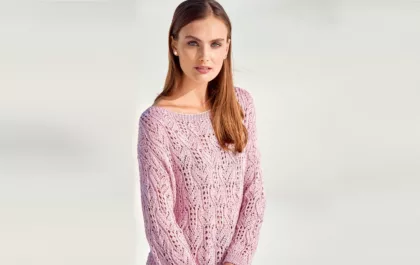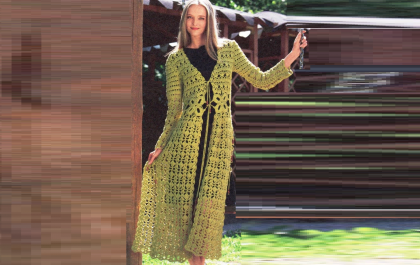No one will argue that knitting is not only a form of creativity, but also relaxation. Sit, knit, create useful and beautiful things in passing. Stop. This is where all the deceit lies.
To create a truly beautiful thing, you must first, before starting knitting, do a very boring, tedious, but necessary job - calculate the yarn consumption for the product.
Why count yarn consumption?
It’s very good if you knit a pattern from some source - from a magazine, for example. There is practically nothing to calculate. Everything has already been indicated: the number of yarn, the number of knitting needles or hook, and the number of threads, and what size the sample should be. However, standard sizes for women are almost never found in nature: some have longer or shorter arms, some have higher chests, some have a long waist. Just as seamstresses adjust patterns, knitters sometimes have to adjust the yarn consumption when knitting and crocheting.
This is without mentioning those cases when you knit something “out of your head”. Here you really can’t do without calculation.

Yarn secrets
But before we study the calculation algorithm, I would like to tell you some secrets of yarn that not every even experienced knitter knows about. Although only with experience will you learn to truly use these secrets.
However, you need to know that:
- the thicker the thread, the less it goes away;
- weak twist threads are more economical than strong twist threads;
- It takes less thread for the front surface than for patterned knitting;
- in turn, openwork requires less yarn than knitting;
- with the same thickness of yarn, consumption will be more economical if knitted with thick knitting needles. However, thicker knitting needles cannot always be used - mainly when knitting from fluffy or fleecy yarn.
Thus, even before starting work, you must decide not only on the general appearance of the model, but also on its details: what yarn will be used, what pattern, what knitting needles. Also, in order for the suit to “fit”, you need a pattern. Otherwise, how to calculate the yarn consumption when knitting if you don’t know what size the product is?
Yarn calculation methods: sample
The most tedious, but also the most accurate way is knitting pattern. Knit a swatch using your chosen yarn in your chosen pattern. Wash it as you would wash a product, dry it, and steam it with an iron. And then we proceed in one of two ways.
- 1. Calculate the weight of the yarn
When the sample has passed all tests, weigh it on a kitchen scale. Also calculate its area. Make a pattern for the product and calculate its area too. Next we calculate using the formula:
weight of yarn required = (area of the product multiplied by the weight of the sample) divided by the area of the sample
Why? Proportions, school curriculum.
- 2. Calculate the yarn footage
A little more complicated: you will need to measure how much yarn is used to knit a sample. You can do it simply: measure by meter and tie a bright thread. Then, when the sample is connected, count the number of full meters plus the “tail”. How to calculate the length of the ponytail? Measure what is left of the full meter and subtract from it.
Then we will subject the sample to the “hellish torment” of washing, drying and steaming, and again calculate its area. The area of the finished product is equal. We calculate the footage like this:
required yarn length = (area of the product multiplied by the length of the thread) divided by the area of the sample
It is more convenient to calculate the consumption of bobbin yarn based on the meter. At the very least, you will be able to immediately understand after the test whether you have enough threads in the intended number of folds to knit the product. And if not, then the number of threads can be reduced and counted again.
Ready tables
Do you think that you cannot cope with such difficulties? Then you can use ready-made tables compiled by the efforts of many experienced knitters. So:

When calculating the required amount of yarn, two main units of measurement are used: the mass of the skein and the length of the thread in the skein (meterage). Manufacturers usually indicate both of these values on the labels. Our experience has shown that it is more accurate to navigate by footage. So, for example, a women's sweater from sizes 44 to 52, medium length and with sleeves, knitted with dense stockinette stitch, will require 1100-1300 meters of yarn. If the sweater size is more than 52, you will need 200 meters more yarn for each subsequent size. That is, for a size 54 sweater you need approximately 1200+200+200=1600 meters. Also add another 200-300 meters if the product is planned to have a “braid” pattern.
If you plan to knit openwork, multiply the initial amount of yarn by 1.3-1.4.
If you plan to knit English rib, multiply the initial amount of yarn by 1.5-1.6.
A poncho requires a little more yarn than a sweater (20-25%).
Also, more yarn is usually required to knit a men's sweater. In addition, men have longer arms than women, i.e., more yarn goes to the sleeves.
By the way, approximately 1/3 of the total volume of yarn is spent on sleeves. That is, for a vest you can use 30% less yarn than for a sweater.
If the product is crocheted, you will need 2 times more yarn than for knitting. So, a simple summer sundress (up to size 48) requires 2500-3000 meters of yarn.
The fluffier the yarn (more airy) and looser the twist, the less it is consumed. For example, a skein of yarn weighs 50 grams, and the length of the thread in a skein is 550 meters (this is a thin and fluffy thread). Thus, for a women's sweater of size 46, knitted in one thread, 2-3 skeins are enough, depending on the planned type of knitting.
At the same time, thicker yarn, with a skein weight of 50 g and a length of 200 m, will take about 7 skeins for a similar product.
As you can see, in the second option the thread consumption is greater. However, you will knit a sweater with thick yarn faster than with more economical but thin yarn. So everything has its pros and cons.
If you focus on the weight of yarn, then for classic winter yarn of medium thickness the numbers are approximately the following:
- women's sweater 400-800 grams
— men's sweater 900-1200 grams
— hat — up to 100 grams
- scarf 200-300 grams
- children's sweater (for a child under 3 years old) - 150-400 grams
- children's pants (for a child under 3 years old) - 150-250 grams
Advice: it’s better to play it safe and take a little more yarn than not take enough. After all, it may happen that exactly this yarn (color) will no longer be on sale (dismantled, discontinued, out of stock, etc. - anything can happen in life).








Yarn meter calculation


On the packaging of yarn (usually on threads in bobbins) numbers No. 322, 204, 402 are indicated ... this is the length of the thread, the so-called metric.
It is very easy to calculate it using these numbers.
For example, for the first designation of yarn 322: 32 is the number of the yarn, 2 is the number of threads of which the yarn consists, and 32 divided by 2 is the length of the thread in 1 gram of yarn (this number 16 is often called the total number of yarn), t i.e. 16 meters in 1 gram or 1600 meters in 100 grams.
This is a very thin yarn and is usually knitted in 2 or even 3 plys. But it is possible to vary the thickness of the knitted fabric and do very interesting things.
Yarn 204 – total number 5 – length of thread in a 100 gram skein = 500 meters.
Yarn 402 – total number 20 – thread length in 100 grams = 2000 meters – this is industrial yarn.
Wool blend yarn 123 - 400 meters in 100 grams - in 1 thread for a thin women's jumper.
242 - 1200 meters in 100 grams - in 3 threads for children's things.
Several average figures for yarn consumption for some products.
For a children's hat, scarf and mittens, you need 200 grams of yarn (with a thread thickness of 400 meters per 100 grams - this is either 32\2 in four folds or standard 50-gram skeins with a thread length of 200 meters - this is now a very common half-wool or wool yarn ). When knitting on needles No. 3.
To knit adult mittens you will need 70 -100 g of yarn
For a jumper for a boy 8-10 years old, you need approximately 500 grams of yarn or 1000-1100 meters if knitted on knitting needles No. 3.5.
For a blouse for a girl (bust volume 80, blouse length along the back 40-42 cm), the yarn consumption is 350 grams or a little more than 1000 meters. Knitting needles number 3 or even 2.5.
For a women's jacket size 46, 60 cm long, you will need about 700 grams of yarn with a total thread length of 1600 meters and knitting needles No. 5 or 6.
How to calculate more accurate yarn consumption.
This is a very approximate yarn consumption.
If it is possible to knit a sample from this or similar yarn before purchasing yarn, then you can more accurately calculate the yarn consumption for the product.
To do this, you need to knit a sample of approximately 20-20 cm with the same knitting needles and the same basic knitting as the intended item, weigh, wash, and measure (weigh before washing).
Calculate the area of the sample; if there is no shrinkage after washing, then the area is s = 0.04 m, and, let’s say, the weight of the sample is m – grams.
Next, you need to calculate the area of the pattern, for example, for a women's jacket of size 44 (Soviet) with a simple cut, the area of the total knitted fabric (S) is approximately 1-1.2 m.
And then calculate:
Multiply the resulting area for the entire product (S) by the weight of the sample (m) and divide by the area of the sample s=0.04 m.
This method has to be used when there is yarn without labels, it is not clear when and where it was purchased.
If the product is knitted in more than one knitting stitch, and this is most often the case, it is necessary to take into account that more yarn is used for various types of elastic bands and, conversely, with openwork knitting, the yarn consumption decreases.




How can I recalculate the product description to fit my size? How to calculate yarn consumption for your size?
How can I recalculate the product description to fit my size?
The simplest thing is to change the length. You just need to measure what length you need for the product or sleeve.
If you need to change the width at the hips, waist or chest, measure your hips (chest, waist) and divide the measurement in half. Add extra allowance for seams and for loose fit.
Let's look at an example?
In this description, the width of the product is 59 cm.
Let's assume that your hip circumference is 60 cm, you will sew with crochet. This means you will need 60 + 0.5 * 2 (for seams) + 3 (looseness of fit) = 64 cm.
And in the chest, let’s assume the half-circumference is 48 cm (pear shape). The model is loose across the chest, which means there is no need to count anything here.
Let's say you want 70 cm in length.
Here you need to take the time to draw your own diagram. It will be much more convenient to work with the diagram later.
So, you have a product width of 64 cm and a product length of 70 cm.
And according to the calculated sample, you got a density of 35 loops and 57 rows = 15*15 cm.
We use proportion.
If 35 loops are 15 cm,
Then X loops – 64 cm
Those who have completely forgotten mathematics, or are simply lazy, can use the online proportions calculator. For example this click
And in your model, with the calculated knitting density, it turns out that you need 150 loops - and 266 rows.
How to calculate yarn consumption for your size?
In fact, it’s also simple. And also, using proportion
In the description, the area of the part is 59*60=3540 sq. cm. Let's multiply this figure by 3, because there is a front part. Back detail. And two sleeves, which are usually approximately equal to one part.
Got
3540*3=10620 sq. cm.
And according to your calculations you need 64*70=4480 sq. cm for one part and 4480 * 3 = 13440 sq cm for the entire product.
The description states that 260 grams of yarn is required.
Let's make a proportion
10620 – 260 g yarn
13440 – x g yarn
We think that you will need 330 grams. Let's take it with a reserve, let it be 350 grams.

Related posts
About the Author

Welcome !
My name is Lilia. The main hobby of my life is knitting. I started with knitting needles and switched to a knitting machine. In 1988 I got acquainted with crochet - Romanian lace. About 10 years ago I became interested in Irish lace and Shetland knitting. And now I’m trying fillet crochet. On this site I want to share with you my 45 years of experience in various knitting techniques.
Latest publications
Пуловер с ажурным узором из «листьев»
Пуловер нежно-розового цвета ручной работы, связанный ажурным узором из шелковистой пряжи.
Black openwork jumper
Set “Crystal Rose”
Knitted coat with an openwork pattern in light green color
Knitted coat with an openwork pattern in light green color
Blog Subscription
Be the first to receive new items!



